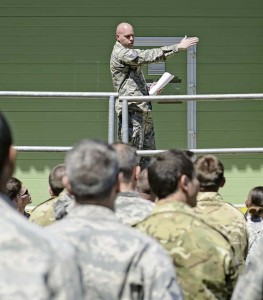Each year, the 435th Air Ground Operations Wing’s Contingency Response Group hosts International Jump Week to bring partner nations’ airborne units together to conduct training and foster working relationships.
The event gives joint-nation jumpers the opportunity to learn how other countries operate their missions and discuss the importance of rapport with allied nations.
“The most important factor is presenting a safe operating environment for all airborne activities,” said Tech. Sgt. Brian Angell, 435th CRG personnel parachute program manager. “Once that is established, the focus shifts to bringing the airborne community together to increase capabilities among the units; building partnerships is always a top priority.”

U.S. Air Force Tech. Sgt. Brian Angell, 435th Contingency Response Group personnel parachute program manager, directs people from different nations during International Jump Week May 4 at Rhine Ordnance Barracks. More than 300 jumpers from nine different nations performed a total of 404 static-line jumps and 132 high-altitude low-opening jumps in three days.
With a large event comes a lot of planning. As hosts, the 435th CRG begins constructing the fine details of International Jump Week as early as six months in advance.
There are many steps that go into planning the event that some people may not realize, Angell said.
“Planning takes the most amount of work to get all the support elements lined up for the week,” he said. “I started planning in October to ensure we had airlift established not only for the C-130Js (Super Hercules) with the 37th Airlift Squadron at Ramstein, but also a C-17 (Globemaster III) assigned to NATO’s Heavy Airlift Wing out of Papa Air Base, Hungary. Referencing regulations was another planning piece to ensure we had approval to bring partner nations here to conduct training and allow them to exit using our parachutes and aircraft. Once set, I had to reserve airspace to drop paratroopers, and line up enough parachutes to support the entire operation.”
What makes International Jump Week diverse is the participation of other nations. The 435th CRG also takes great care to plan in such a way that intertwines the cultures.
“The vast majority of my time during jump week is spent coordinating with our partner nation jumpmasters to ensure their personnel are taken care of,” said Staff Sgt. Brandon Fountain, 435th CRG jumpmaster. “I ensure proper training is conducted and organize the military free fall jumpers into smaller groups, focusing on mixing units to truly accomplish combined training at 13,000 feet above ground level.”
International Jump Week allows the jumpers to build partnerships and strengthen deployment bonds by allowing them to do what they do best. The camaraderie of International Jump Week leaves the participants with memories of a lifetime.
“This year on the final day of jump week, the weather was not cooperating for free fall operations thus giving us only one opportunity to allow free fall parachutists to exit,” Fountain said. “After flying for close to two hours, we exited 41 free fall jumpers from seven countries in one pass at 7,500 feet above ground level from a C-17. The majority of jumpers had never jumped from a C-17 before and not a single person had jumped with that many people at one time. It was widely agreed that this jump will be the one we will tell stories about in 20 years.”
Though free falling from an aircraft may seem like fun or even terrifying, there is an important reason for jump week.
“International Jump Week is important in maximizing the number of partner nations on how to operate with different airborne units,” Angell said. “The event we held this year tripled the number of nations we normally support, so the chance to get hands-on training, not just for the U.S. forces, but each nation, really increased options for integrating different units.”
International Jump Week has ended, but the 435th CRG continues to plan and organize for future exercises to ensure the U.S. and its allies are ready for any emergency.


